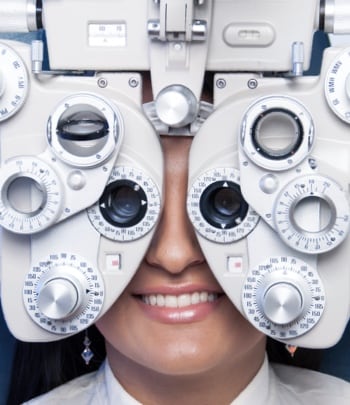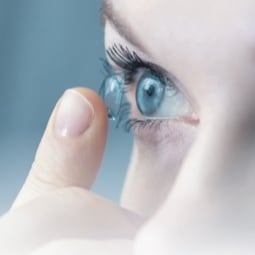Eye Exams Are the Key to Unlocking Healthy Vision
At Total Vision Long Beach, formerly Dr. Goldstone Vision Center, we believe in providing you with meaningful strategies for managing your eye health. One of the ways we do this is by looking for any possible issues that could affect your eyes or vision, ranging from refractive errors to eye disease.
Detecting eye disease is arguably one of our team’s most important responsibilities, and comprehensive eye exams are essential to upholding our commitment to your eye health.
Find out how we can support your eyes and preserve your vision by booking your next eye exam with our team today.
How We Look for Eye Disease
Many eye diseases and conditions subtly develop over time, and some may not present any noticeable symptoms until your eyesight is already permanently affected. Detecting these diseases as early as possible is essential for managing their symptoms and preserving your sight, and we use an array of technologies to look for these issues.
During an eye exam, we observe several parts of your eye that may risk developing a disease. We can even tailor the exam if you have certain conditions that may increase your risk of developing a specific eye disease.
Some of the structures we examine include the retina, macula, and optic nerve. These areas are essential to your vision and may have a risk of developing various diseases.


Common Eye Diseases We Look For
Everybody is different, so the risk of developing an eye disease changes for everyone.
We look for potential issues that may increase your risk of eye disease during our eye exam process, like diabetes, genetics, and lifestyle habits. If we detect an eye disease, our team will get to work developing a management strategy that could help preserve your vision.
Our team is ready to help care for your eyes—all you have to do is book an eye exam.
Glaucoma
Glaucoma is a group of eye diseases that affect your optic nerve, a part of your eye responsible for transporting signals from your retina to your brain.
The most common types of glaucoma are characterized by causing high internal eye pressure (intraocular pressure, or IOP), but some versions may develop even if your IOP levels are within a normal range.
There are 3 common types of glaucoma, and we can help detect each during an eye exam:
Open-Angle Glaucoma
Open-angle glaucoma is the most common form of glaucoma, sometimes known as the “silent thief of sight.”
Open-angle glaucoma may develop when blockages form in your eye’s natural drainage system. Over time, your IOP levels rise, which can eventually damage your optic nerve and lead to vision loss.
You may not notice symptoms during the early stage of open-angle glaucoma, but it could lead to permanent vision loss without proper care and management. Diabetes can also double your risk of developing this disease.
Angle-Closure Glaucoma
Angle-closure glaucoma, sometimes called closed-angle glaucoma, is a version of the disease known for rapidly raising your IOP levels and causing sudden emergency symptoms.
Angle-closure glaucoma occurs when the drainage angle (a small passageway between your iris and cornea) closes. As a result, fluids in your eye can’t drain properly, and your IOP levels can increase dramatically. You may experience redness, eye pain, nausea, headaches, or sudden vision loss in a short period.
We treat angle-closure glaucoma as an emergency. If you experience the above symptoms, please call our team or visit the nearest emergency room immediately.
Normal-Tension Glaucoma
Normal-tension glaucoma is a unique version of the disease that can develop without affecting your IOP levels.
Doctors aren’t sure how normal-tension glaucoma can develop, but we can help detect the disease by observing your optic nerve during an eye exam.
Age-Related Macular Degeneration
Age-related macular degeneration (AMD) is an eye disease that affects your macula, a part of your eye responsible for providing the sight you use to see fine details.
AMD is one of the leading causes of vision loss in adults over 55, and there are 2 different versions you may develop:
Dry AMD
Dry AMD is the most common version of the disease and can thin your macula over time.
Doctors aren’t sure how dry AMD develops, but some research suggests it may be related to a lipid called drusen developing underneath the macula.
Wet AMD
Wet AMD isn’t as common as dry AMD, but it’s responsible for 90% of all AMD-related vision loss. Wet AMD occurs when abnormal blood vessels grow underneath the macula.
Because of how weak these blood vessels are, they can break and leak fluid, damaging your macula. Wet AMD may cause sudden vision loss and could require emergency eye care.
Diabetic Eye Disease
Diabetes can affect several aspects of your health, like increasing your risk of developing various eye diseases.
Diabetic retinopathy and diabetic macular edema are some of the most common eye diseases related to diabetes, but it can also increase your risk of developing open-angle glaucoma and cataracts.
Please visit our Diabetic Eye Exams page for more information.
Cataracts
Cataracts are common eye conditions that many people develop with age, sometimes leading to vision problems that may require glasses, contact lenses, or cataract surgery to help correct.
As you grow older, proteins in your eyes clear, crystalline can start to break down and clump together. This process can eventually make your lens more rigid while also forming a hazy, milky appearance that can obstruct your vision.
Advanced cases of cataracts could cause blindness, but cataract surgery can help by replacing your cataract lens with an artificial intraocular lens.
Discover Our Commitment to Your Eye Care
Dr. Goldstone Vision Center wants to help you and your family maintain your eye health and vision. Find out how when you book an appointment today.
Visit Us Today

Visit us
Find us in Long Beach Town Square shopping center, right next to the Starbucks.
- 2280 E Carson Street
- Long Beach, CA 90807
Hours of Operation
- Monday: 9:00 AM – 5:30 PM
- Tuesday: 9:00 AM – 5:30 PM
- Wednesday: 9:00 AM – 5:30 PM
- Thursday: 9:00 AM – 5:30 PM
- Friday: 9:00 AM – 5:30 PM
- Saturday: Closed
- Sunday: Closed


Our Brands




Our Google Reviews
Be the First to Know,
Be the First to Win.
From eye health insights to exclusive giveaways, your feed just got a lot clearer.








